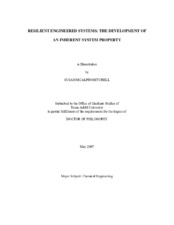| dc.description.abstract | Protecting modern engineered systems has become increasingly difficult due to their complexity and the difficulty of predicting potential failures. With the added threat of terrorism, the desire to design systems resilient to potential faults has increased. The concept of a resilient system – one that can withstand unanticipated failures without disastrous consequences – provides promise for designing safer systems. Resilience has been recognized in research settings as a desired end product of specific systems, but resilience as a general, inherent, measurable property of systems had yet to be established. To achieve this goal, system resilience was related to an established concept, the resiliency of a material. System resilience was defined as the amount of energy a system can store before reaching a point of instability. The energy input into each system as well as the system’s exergy were used to develop system stress and system strain variables. Process variable changes to four test systems – a steam pipe, a water pipe, a water pump, and a heat exchanger – were applied to obtain series of system stress and system strain data that were then graphed to form characteristic system response curves. Resilience was quantified by performing power-law regression on each curve to determine the variable ranges where the regression line accurately described the data and where the data began to deviate from that power-law trend. Finally, the four test systems were analyzed in depth by combining them into an overall system using the process simulator ASPEN. The ranges predicted by the overall system data were compared to the ranges predicted for the individual equipment. Finally, future work opportunities were outlined to show potential areas for expansion of the methodology. | en |


